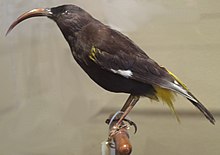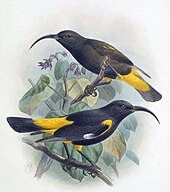Hawaii mamo
| Hawaiʻi mamo | |
|---|---|

| |
| Specimen | |
| Scientific classification | |
| Domain: | Eukaryota |
| Kingdom: | Animalia |
| Phylum: | Chordata |
| Class: | Aves |
| Order: | Passeriformes |
| Family: | Fringillidae |
| Subfamily: | Carduelinae |
| Genus: | Drepanis |
| Species: | †D. pacifica
|
| Binomial name | |
| †Drepanis pacifica (Gmelin, 1788)
| |
The Hawaiʻi mamo (Drepanis pacifica) is an extinct species of Hawaiian honeycreeper. It was endemic to Hawaii Island. It became extinct due to habitat loss, mosquitoes, introduced predators such as the small Indian mongoose, and overcollecting.
Description

The bird's natural habitat was limited to the Big Island (Hawaii Island).[3][4] This bird averaged 9 inches (22.86 cm) in length. It was mostly black with bright yellow feathers on its rump, undertail coverts, shoulders, and legs. There was a white patch on the primaries. It had small, black eyes and was the centerpiece of portraits. It had a slightly decurved blackish bill, some three inches long. Juveniles may have been brown.[5] This shy species lived in the forest canopy and fed particularly on lobelioid nectar (Lobelia[6] as well as Cyanea ≈ hāhā[4][8]), from the plant's curved, tubular flowers, as flowers of Pritchardia palms.[6] There is anecdotal evidence they may have been partly insectivorous.[10] According to Palmer, the bird was also fond of the berries of the hāhā, and ironically the berry juice could be made into quality birdlime.[11] Its call was a long, plaintive whistle.[12]
In Hawaiian culture
The mamo was one of the most honored birds in pre-European Hawaiian society. Its yellow feathers were used to create capes and hats (featherwork) for royalty.[13] Feather collecting contributed to the bird's decline. The famous yellow cloak of Kamehameha I is estimated to have taken the reigns of eight monarchs and the golden feathers of 80,000 birds to complete.[13]
The natives caught the bird by noose or by birdlime, and would lure it by imitating its call.[14] The call is said to be "a single rather long and plaintive note"[12] so this may have been a song rather than a call.[4] The Hawaiian recipe for their sticky birdlime consisted of sap from breadfruit (Hawaiian: ʻulu)[15][16] and lobeliods.[17]}}
The native feather-hunter (poe kawili) had developed (at the behest of King Kamehameha[15][9]) the practice of sparing and releasing any birdlime-caught birds with only a few (yellow) feathers to be harvested, namely the ʻōʻō and the mamo.[18][19] However by the 19th century, the kapu against killing mamo and ʻōʻō was not being strictly observed and these birds were being eaten by natives, as ornithologist Henry W. Henshaw suspected,[9] and native historian David Malo has confirmed.[20] Henshaw attributes the acceleration towards extinction to adoption of shotgun-hunting over traditional birdliming.[9]
Settler impact and extinction
Due to their bright colors, the birds were also popular with European collectors.
European settlers changed the mamo's habitat to support agriculture and cattle ranching, which damaged the bird's food source. Cattle roamed loose in the forests, destroying the understory ecosystem. Small Indian mongooses were introduced to control rats, but they also preyed on native birds. Even though this was discovered early and was well known to the Hawaiians, the mamo quickly disappeared.
Introduced disease may have killed any birds that survived habitat destruction. There are many specimens of this bird in American and European museums. The bird had not been particularly scarce until the 1880's.[14][21] But the last live specimen was obtained by Henry C. Palmer in 1892 (this birds has been reported as tame unafraid when captured;[14] Palmer's specimen fed on "sugar and water eagerly", and would stay perched on a twig in the tent[14]).[22][25] The last confirmed sighting dates to July 1898 near Kaumana on the Island of Hawaiʻi, as reported by a collector, Henry W. Henshaw,[26] Henshaw in correspondence to Rothschildrevealed that when he spotted and he stalked a family of them, he actually shot and wounded one of them, though it escaped.[27][28]
Explanatory notes
References
- Citations
- ^ BirdLife International (2016). "Drepanis pacifica". IUCN Red List of Threatened Species. 2016: e.T22720848A94686625. doi:10.2305/IUCN.UK.2016-3.RLTS.T22720848A94686625.en. Retrieved 13 November 2021.
- ^ "Drepanis pacifica. NatureServe Explorer 2.0". explorer.natureserve.org. Retrieved 1 May 2023.
- ^ a b Force, Roland W.; Yapp, William Brunsdon (1968). Art and Artifacts of the 18th Century: Objects in the Leverian Museum as Painted by Sarah Stone. Bishop Museum Press. p. 46. ISBN 9780715622384.
- ^ a b c d e f g Pratt, H. Douglas (2005). The Hawaiian Honeycreepers: Drepanidinae. OUP Oxford. pp. 269–270. ISBN 9780198546535.
- ^ http://julianhume.co.uk/wp-content/uploads/2010/07/Olson-Hume-Drepanis-plumages.pdf [bare URL PDF]
- ^ a b Greenway, James C. (1931). Extinct and Vanishing Birds of the World. New York: American Committee for International Wild Life Protection. p. 418.
- ^ Rothschild (1900), pp. 160–161.
- ^ Palmer's diary, 13 April 1892.[7]
- ^ a b c d e Henshaw, H. W. (1902). Birds of the Hawaiian Islands: Being a Complete List of the Birds of the Hawaiian Possessions, with Notes on Their Habits. Honolulu: Thomas G. Thrum. p. 418.
- ^ Henshaw reported seeing a pair (before extinction) chasing insects,[9] also quoted by Pratt[4]
- ^ a b Rothschild (1900), p. 162.
- ^ a b The call was demonstrated to Perkins (1903), p. 399).[14][4]
- ^ a b Quammen, David (1996). The Song of the Dodo: Island Biogeography in an Age of Extinctions. New York, NY, US: Scribner. p. 318. ISBN 0-684-80083-7.
- ^ a b c d e Munro, George C. (2012) [1960]. Birds of Hawaii. Tokyo: Tuttle Publishing. ISBN 9781462909544.
- ^ a b c Degener, Otto (1930). Illustrated Guide to the More Common Or Noteworthy Ferns and Flowering Plants of Hawaii National Park: With Descriptions of Ancient Hawaiian Customs and an Introduction to the Geologic History of the Islands. Honolulu Star-Bulletin. pp. 129–130.
- ^ a b Little, Elbert L., Jr.; Skolmen, Roger G. (1949). Common Forest Trees of Hawaii (Native and Introduced). Agriculture Handbook 679. U.S. Department of Agriculture. p. 100.
- ^ Palmer's noting that hāhā berries became birdlime, as already noted.[11] Otto Degener says " fruit of plants belonging to the groups called lobelia" (p. 129), where he cross-references to his explanation of "lobelia" known by the Hawaiian names oha (ʻōhā) or ohaha (ʻōhāhā)(p. 288).
- ^ Hiroa, Te Rangi (1944). "The Local Evolution of Hawaiian Feather Capes and Cloaks". The Journal of the Polynesian Society. 53 (1): 10. Archived from the original on 2008-10-14.
Apart from the few 'o'o that were killed for specific purposes, the birds caught with bird lime were plucked of their yellow feathers without harm and set free to maintain a future supply. As the duller black feathers of the mamo were not used, it is probable that they were never killed wittingly.
- ^ Little & Skolmen,[16] citing Degener.[15]
- ^ Malo, David (1903). Hawaiian Antiquities: (Moolelo Hawaii). Translated by Emerson, Nathaniel Bright. Honolulu: Hawaiian Gazette. pp. 63, 106–107. ISBN 9781785702181.
- ^ Though Force&Force (1968) writes that it became extinct by the 1880's.[3]
- ^ Pratt: "by a native collector, working for Henry Palmer" in 1892".[4] citing Munro (1960).
- ^ Rothschild (1900), p. 161.
- ^ Rothschild (1900), p. (Di.) 7.
- ^ 16 April 1892, captured by Ahulau, who set snare and birdlime on the hāhā.[23] cf. also resumé of Palmer's diary.[24]
- ^ Pratt,[4] citing Henshaw (1902).[9] Henshaw writes that a year after his own sighting, a native catcher reported hearing the bird's call, but nevertheless did not lead to capture, thus dating the extinction to 1899.
- ^ W. H. Henshaw, correspondence to Rothschild dated 9 October 1899, concerning the mamo sighting in July the year before, printed in Rothschild (1900), pp. 161–162
- ^ Flannery, Tim Fridtjof (2001). A Gap in Nature: Discovering the World's Extinct Animals. Illustrated by Peter Schouten. Atlantic Monthly Press. p. 88. ISBN 9780871137975.
- Bibliography
- Rothschild, Walter (1893–1900). The Avifauna of Laysan and the Neighbouring Islands : with a complete history to date of the birds of the Hawaiian possessions (PDF). London: R. H. Porter.; also copy @ biodiversitylibrary.org
External links
- Naturalis.nl: 3D view of Drepanis pacifica specimen (RMNH 110.030) — (requires QuickTime browser plugin).


